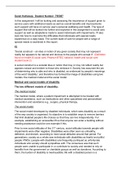Sarah Hathaway Student Number :795087
In this assignment I will be looking and assessing the importance of support given to
service users with additional needs as well as overall benefits and improvements
such support will have on service user’s personal wellbeing and health. The type of
support that will be looked into further and explored in this assignment is social care
support as well as adaptations made to assist individuals with impairments. I'll also
look into how to overcome the difficulties that individuals with special needs
experience on a daily basis. The current state of care for people with a range of
special needs is examined in this report.
P2
“Social construct – an idea or notion of any given society that may not represent
reality but appears to be natural and obvious to the people who accept it”. (Definition
found on health & social care, Pearson BTEC national, health and social care
student book 2)
A social construct is a societal idea or notion that may or may not reflect reality but
appears natural and evident to those who embrace it. Society has assumed the job
of determining who is able and who is disabled, as evidenced by people's meanings
of the word 'disability,' and therefore has formed the image of disabilities using two
models: the medical model and the social model.
Medical and social models of disability
The two different models of disability:
The medical model:
The medical model, where a patient impairment is attempted to be treated with
medical assistance, such as medications and other specialised and personalised
intervention and assistance e.g., surgery, physical therapy.
The social model:
The social model developed by disabled individuals, which sees disability as a result
of the way society is organised. Its objective is to establish ways to remove barriers
that limit disabled people’s life choices so that they can live independently. For
example, establishing an accessible lift so that anyone can enter a building without
needing assistance could be one example if this.
Prior to new social attitudes of the 21st century, social attitudes towards people with
impairments were often negative. Disabilities were often seen as unhealthy,
defective, and deviant, according to most social attitudes around that period. For
generations, society as a whole saw individuals with disabilities as fearful and pitiful
people. PWDs ( people with disabilities) are frequently portrayed as unfortunate
individuals who society should sympathise with. The consensus was that such
people were unable to participate in or contribute to society and needed to rely on
benefits from the government or charitable groups as well as donations. According to
them, the burden of disability is inexhaustible; life with a disabled person is a
, constant source of sadness and agony, and the able-bodied are obligated to assist
them at all times.
Throughout recent times, however, this has been viewed as a social construct. The
disability model, which has been developed by disabled people, suggests that
society really shouldn't view individuals as disabled, but rather that techniques
should be in place for individuals with relevant needs to feel equal to individuals who
haven't had those needs and are able to live life independently, without reliance on
family, friends, or caregivers to support them with basic activities of daily living.
The social model was designed by disabled people for disabled people in order to
easily spot inequalities and injustice and they have found that disability to them
have be created as a social problem. A society has indeed been built that restricts
wheelchair users like Rebecca, making them unable to function. This concept aims
to identify ways to reduce barriers for service users, allowing them to make full
lifestyle choices that allow them to live freely. Which would be a huge benefit for
service user Rebecca and empower her hugely as , this may entail the use of
elevators and ramps to guarantee that she has accessibility to any building without
requiring help and to enable her to perform daily activities.
When a person loses a function of any portion of their body, whether physical or
mental, such as cognitive impairment, society classifies them as disabled, and the
tests used to measure cognitive ability are developed by people who decide what is
and is not competent. This is a frequent occurrence in Ben's life as a result of
stereotypes and general cliches that declare each individual with Down's Syndrome
to be on the same level of thinking, capacity, and understanding (also believing that
he is unable to understand what your trying to get across to him) when, in actuality,
each person is impacted differently and thus should not be treated the same or
placed under the premise that they are incapable.
P3
Case Study 1 . Rebecca Brown ( Child Study)
A health professional that would help Rebecca with her additional needs and
overcome challenges that she faces in everyday living would be a community
learning disability nurse. The main outcome that a community learning disability
nurse will strive for when working with service users like Rebecca is to ensure they
reach their full potential by providing them with the right amount of support needed in
order for them to flourish. Their job role involves helping a service user by improving
their physical and mental health. They actively work in a range of different health and
social care settings e.g. a service users own home, educational settings, there own
workplace or even community and residential homes. But what they are prominently
known for is helping service users like Rebecca who have learning disabilities, by
assisting them and acting as an advocate on there behalf. This can include
explaining what is happening to a service user when confused and assist other
healthcare professionals in understanding the service users needs that requires
support. As Rebecca attends a school for children with additional needs having a
community learning disability nurse in class with her would be beneficial to Rebecca,





